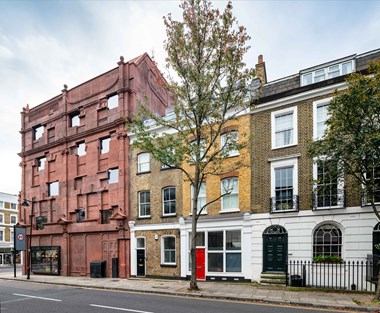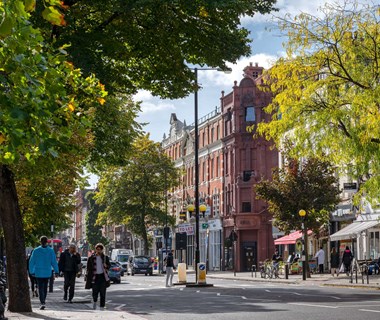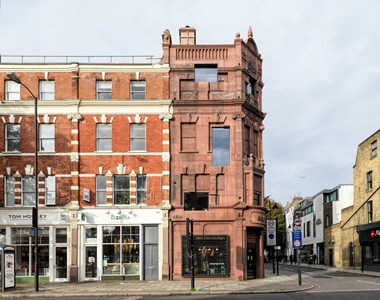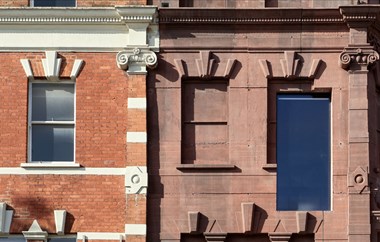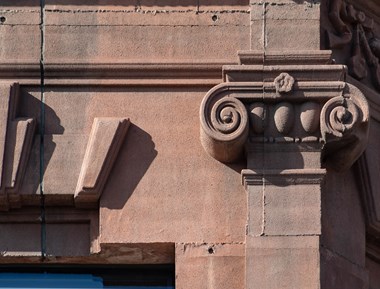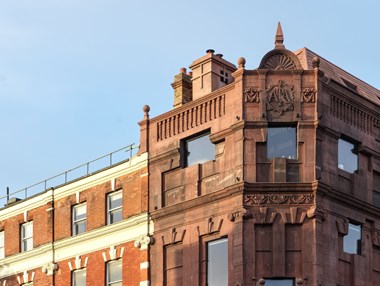Design Case Study: 168 Upper Street, Islington
An imaginative reinstatement of a missing corner building that reproduces the original facade in a contemporary way whilst unifying the Victorian terrace of which it forms a part.
This case study is one of ten studies of new residential or mixed-use developments compiled in 2020 by Purcell on behalf of Historic England.
Project information
- Region: London
- Type of development: Infill development
- Location and postcode: Upper Street / Barnsbury Street, London N1
- Local planning authority: London Borough of Islington
- Architects: Amin Taha Architects
- Developer/land owner: Aria
- No. of residential units: 3
- Site area: Internal area 545 square metres
- Other uses: Retail uses at basement and ground floor
- Awards: RIBA London Award 2019, RIBA National Award 2019
Description of development
Located on a prominent corner site, part of a late nineteenth century parade of buildings in Upper Street, the previous building was significantly damaged during the Second World War and was eventually demolished in its entirety. A design competition was held following purchase of the vacant site in 2012. The ground floor and basement provide retail space. The residential accommodation above comprises a one-level apartment at first-floor level, a duplex apartment on the second and third floors and a further duplex apartment on the fifth and sixth floors. These apartments are accessed from Barnsbury Street via a secret hinged section of the façade which leads through to a glazed passage.
Heritage assets affected
The site is located in the Upper Street (North) Conservation Area. The adjacent block 159-167 Upper Street is not listed or locally listed.
There are a number of Grade II listed buildings along Barnsbury Street, these include:
Planning context
The final design emerged after a period of pre-application consultation with planning officers between June and December 2013. The initial proposal was to form the ‘replica’ building with a veiled facade of bronze metal.
The planners’ preference was for the building to exactly replicate what previously existed. During the pre-application process, planning officers were concerned about the quality of the ‘imprinted’ image of the historic building and about the proposed irregular fenestration which varies from the uniform and regular pattern of window openings which is a strong characteristic of the area.
However, they accepted that an alternative solid material, such as ceramic or terracotta, could be acceptable with contemporary style windows ‘punched’ into the façade. In order to reassure the planners about the appropriateness of the design, the architects included a more detailed design for the terracotta facade with regard to its look and detail. They consulted with the leading craftsman and suppliers of terracotta facades in an effort to bring in their expertise from an early stage.
The planning application (Ref. P2014/0189/FUL) was approved in July 2014.
Assessment of design qualities and relationship to historic environment
The new building completes a long terrace of late-nineteenth century four-storey buildings facing Upper Street.
There is a consistent facade treatment to the whole of this frontage which extends from Waterloo Terrace to Barnsbury Street. The new building reinstates the final unit of this long facade, which is faced in brick with contrasting architectural details – parapet details, string courses, quoin blocks etc, now mostly painted white. On the return elevation along Barnsbury Street, the building abuts an earlier terrace of three-storey houses.
Rachel Whiteread’s ‘House’ - a cast concrete representation of a typical Victorian house – was a conscious influence. Other examples of this approach cited by the architects are the new east wing of the Natural History Museum in Berlin (designed by Diener & Diener), the Hotel Fouquet Barriere in Paris (designed by Edouard Francois) and La Caixa Forum in Madrid (designed by Herzog and De Meuron).
A computer model of the previous building was constructed, based on a study of historic photographs and 3-dimensional point cloud surveys of the site and the intact southern pavilion of the terrace. All external mouldings, window surrounds and features as well as internal skirtings, dado rails, cornices and even anaglypta wallpaper were modelled. Within the monolithic cast shell, floor plates are introduced to suit contemporary needs rather than replicating the historic floor to ceiling heights. A series of purposefully punched window openings align with the new interior to provide the internal spaces of the building with quality amounts of daylight and views out. The depth of the openings gives the impression of a solid terracotta facade wrapping the entire building.
Contributing to the streetscape with remarkable delight this intervention is a 1:1 cast monument and memory to the Victorian terrace which previously existed on this plot. The terracotta tinted concrete facades deftly play with the themes of memory; actual, imagined, created, true and false. Painstakingly cast into machine milled polystyrene moulds constructed from photographs and a digital 3D survey of the mirror corner at the other end of the terrace, it creates, rather than re-creates, sculptural facades which are both energetic and reposeful.
Key points
The design solution emerged following two rounds of pre-application negotiation with local planning officers. It accurately recreates the detail and architectural style of the existing terrace facade in a contemporary and modern way, unifying the block as a whole, whilst achieving a well-detailed and contemporary standard for living and retail.
Views of 168 Upper Street Islington, London
Please click on the gallery images to enlarge.
Design in the historic environment: more case studies
-
Design in the Historic Environment
Principles and case studies for good practice in design when making changes to the built historic environment.
-
Design in the Historic Environment: Case Studies
Download all ten case studies as a PDF document.
-
Design Case Study: Roussillon Park Chichester, West Sussex
A case study of design in the historic environment: Roussillion Park is a modern residential complex at the site of a former barracks in Chichester.
-
Wildernesse House Mews, Sevenoaks
Case study of a new mews-style development within the setting of a Grade II listed mansion and within an area of historic landscape.
-
Bourne Estate, Holborn, London
An award-winning residential extension on a Grade II listed urban estate, bringing together old and new through quality detailing and landscaping.
-
Temple Gardens, Temple Cloud
Design case study of the refurbishment and viable reuse of a listed pub, with a sensitive scheme of new housing and hotel development.
-
Fairmile Hospital
Case study of the re-development of a former hospital on the edge of a rural village with new homes designed as distinctive groups.
-
Garden Quarter, Caversfield
Case study for design in the historic environment of the sensitive redevelopment of a former Royal Air force site into a residential community.
-
Church Fields, Boston Spa
A design case study featuring a residential extension to the edge of an historic village that interprets traditional architectural forms.
-
Timekeepers Square, Salford
Case study of a redevelopment that recreates the vernacular Georgian terrace and urban grain within the setting of a listed church.
-
Welsh Streets Liverpool 8
Case study of an ambitious and popular scheme that converts hundreds of derelict Victorian terraced houses.


